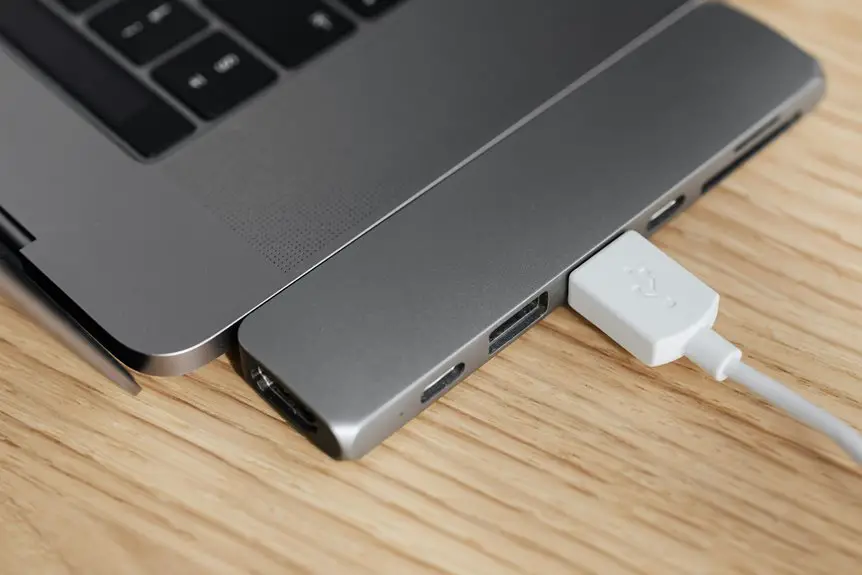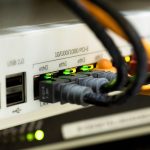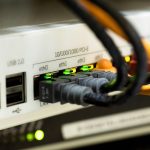To power your USB hub correctly, first check its specifications for voltage and amperage needs. Most hubs use 5 volts, so ensure your power supply meets at least the minimum current requirements. If it's a powered hub, connect it to a suitable power source. Use quality cables for better performance and evenly distribute devices across the ports. If you're facing any issues, there are common troubleshooting steps that can help you resolve them.
Table of Contents
Key Takeaways
- Check the specifications of your USB hub to determine the required voltage and amperage for proper powering.
- Use a powered USB hub with its own power supply for connecting multiple devices without overloading.
- Ensure the power supply meets or exceeds the hub's minimum current requirements for optimal performance.
- Distribute connected devices evenly across the hub's ports to prevent power overload and ensure efficient operation.
- Regularly update device drivers and keep cables high-quality to maintain hub performance and avoid power issues.
Understanding USB Hub Power Requirements
When setting up your USB hub, it's crucial to grasp its power requirements.
USB hubs can either be powered or unpowered. An unpowered hub draws power directly from your computer, which limits the number of devices you can connect and may lead to performance issues.
On the other hand, powered hubs have their own power supply, allowing you to connect multiple devices without overloading your computer's USB ports.
Pay attention to the total wattage and amperage, as this ensures your hub can support all connected devices.
Additionally, check the specifications of each device; some may require more power than others.
Understanding these power requirements will help you maximize your hub's performance and avoid frustrating connectivity issues.
Choosing the Right Power Supply
Selecting the right power supply for your USB hub can significantly impact its efficiency and functionality.
First, check your hub's specifications to determine the required voltage and amperage. Most USB hubs operate on 5 volts, but the current rating can vary. Ensure the power supply provides at least the minimum current needed; otherwise, your hub might underperform or fail to power connected devices.
Consider a power supply with a little extra capacity to accommodate potential future needs. Always opt for a reputable brand to avoid issues with reliability and safety.
Finally, using a power supply with over-voltage protection can safeguard your devices from damage, ensuring a smooth and efficient operation of your USB hub.
Connecting Your USB Hub Properly
Connecting your USB hub properly is crucial for optimal performance. Start by ensuring your hub is compatible with your devices.
Plug the hub into a power source if it requires external power; otherwise, connect it directly to your computer's USB port. Make sure to use quality cables to avoid signal loss.
Once connected, check that all devices are recognized by your system. If your hub has multiple ports, distribute devices evenly to prevent overloading any single port.
It's also a good idea to connect devices in the order of priority; for example, high-power devices should be plugged in first.
Lastly, avoid daisy-chaining multiple hubs, as this can lead to power issues and device malfunctions.
Troubleshooting Common Power Issues
If you're experiencing power issues with your USB hub, you're not alone, and fortunately, there are straightforward steps to diagnose the problem. Start by checking your power source; ensure it's plugged in and working. Next, examine the USB cables for any visible damage. You might also want to test the hub with different devices to pinpoint the issue.
Here's a table to help you troubleshoot:
| Issue | Potential Cause | Solution |
|---|---|---|
| Hub not powering on | Faulty power adapter | Replace with a compatible adapter |
| Devices not charging | Insufficient power supply | Use a powered hub |
| Intermittent connection | Loose USB connections | Reconnect cables firmly |
| Overheating | Poor ventilation | Move to a cooler area |
| Device not recognized | Driver issues | Update or reinstall drivers |
Maintaining Optimal Performance of Your USB Hub
To maintain optimal performance of your USB hub, regular care and attention are essential.
Start by keeping the hub clean; dust and debris can interfere with connections. Ensure you use high-quality cables to prevent data loss or power issues.
It's also crucial to avoid overloading your hub—check its power rating and distribute devices accordingly. If you notice any lag or disconnection, unplug the hub, wait a few moments, and reconnect it.
Regularly update your device drivers to ensure compatibility and efficiency. Lastly, keep your hub in a well-ventilated area to prevent overheating.
Frequently Asked Questions
Can I Use a Power Bank to Power My USB Hub?
Yes, you can use a power bank to power your USB hub, as long as the power bank provides sufficient output. Just ensure it's compatible with your hub's voltage and current requirements for optimal performance.
What Happens if I Overload My USB Hub?
If you overload your USB hub, it can stop functioning properly, leading to device disconnections or damage. You might notice performance issues or even risk overheating, which can harm your devices or the hub itself.
Are There Any USB Hubs That Don't Require External Power?
Yes, there are USB hubs that don't require external power. These powered hubs draw energy directly from your computer's USB port, making them portable and convenient for light devices like keyboards and mice.
Can I Daisy-Chain Multiple USB Hubs for More Ports?
Yes, you can daisy-chain multiple USB hubs to expand your available ports. Just ensure your USB hubs support daisy-chaining and that your devices don't exceed the total power and bandwidth limitations of your computer.
How Do I Know if My USB Hub Is Faulty?
To determine if your USB hub's faulty, check for inconsistent power, unresponsive ports, or device recognition issues. If devices fail to connect or charge, it's likely time to replace or troubleshoot your hub.




